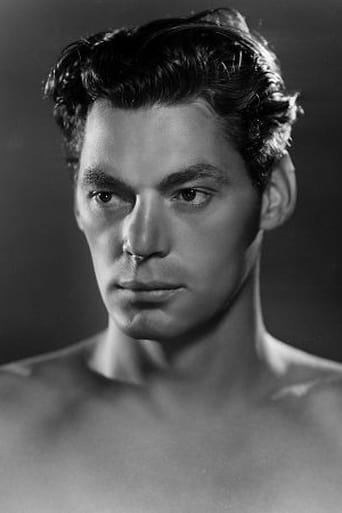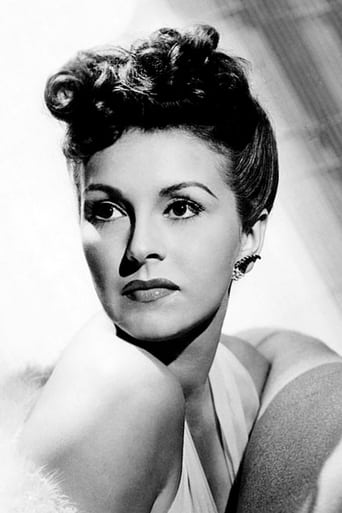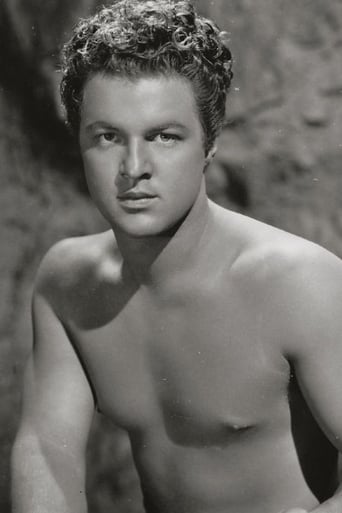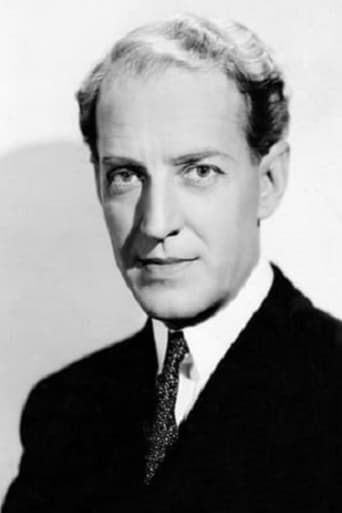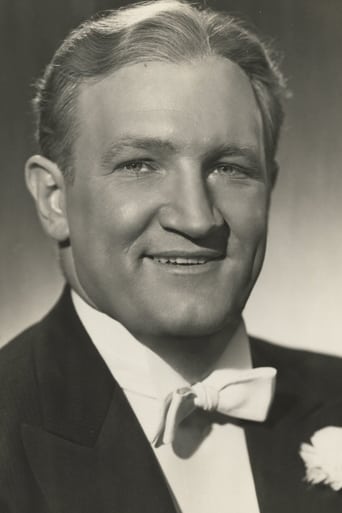a_chinn
Tarzan and Boy meet a magician entertaining troops in North Africa, Nancy Kelly, on her way to warn a sheik about evil Nazi plans to steal horses. Tarzan and Boy are wrongfully put in jail for stealing the horses, but break out to stop the evil Nazi plan. It's the usual Tarzan nonsense you'd expect, but it's all quite enjoyable, which includes giant lizards, killer spiders, and a man-eating plant. Top that all off with Hollywood WWII propaganda and this is something of a bizarre must-see film for it's era. Otto Kruger also appears in the film (as a Nazi, of course).
Ben Burgraff (cariart)
Following the HUGE success of TARZAN TRIUMPHS, RKO released TARZAN'S DESERT MYSTERY, which again offered Nazi villains (Otto Kruger, who'd played a similar role in Hitchcock's SABOTEUR, a year earlier, and veteran screen baddie Joe Sawyer), an American girl magician (vivacious Nancy Kelly, who sings a mean "Boola Boola"), and a chance to combine Nazi duplicity with an 'Arabian'-themed adventure (which was popular escapism during the war years). Even a fantasy element was tossed in, as giant lizards and a mechanical spider 'passing' as 'prehistoric' appear in a 'lost jungle' climax.The plot is simple; Jane (at this point serving as a military nurse in London), sends Tarzan a letter, asking him to send his jungle fever remedy. The ingredients are in a 'lost' jungle, across a vast desert, leading Tarzan, Boy, and Cheeta into the adventure...Dated, certainly, but a very enjoyable RKO Tarzan entry!
lugonian
TARZAN'S DESERT MYSTERY (RKO Radio, 1943), directed by Wilhelm Thiele, the eighth installment to the long running adventure series starring Johnny Weissmuller as the jungle hero, the second under the RKO Radio banner, and the only time during Weissmuller's 16 years in the titled role to have two releases in the same year. As with TARZAN TRIUMPHS (1943), his mate, Jane, is away (as explained in this segment through the reading of a letter that she away in England helping out in the war effort acting as nurse to the wounded soldiers), leaving her jungle warlord husband to remain behind and look after their young son, Boy (Johnny Sheffield) and their chimpanzee pet, Cheetah. Since this is war time, the screenwriters break away from the traditional intrusion of villainous white hunters or angry natives by having Tarzan matching wits with the Nazis once again. Unlike TARZAN TRIUMPHS, the Nazis take second precedence to what Tarzan is to encounter in his latest caper. Before a new adventure begins for both Tarzan and Boy, the story opens with an airplane flying over Tarzan's destination by which the co-pilot is seen throwing down a rock with an attached letter coming down on a miniature parachute. It is an airmail letter from Jane, which is opened and read to Tarzan by Boy. The letter has Jane asking Tarzan to hunt for giant carnivorous plants (plants with malaria serum), which can be found in the jungle on the other side of the desert, and have it sent to her in order to offer this fever medicine to the soldiers. Although it's written for Boy to remain behind, the young lad manages by getting his way with Tarzan, and, along with Cheetah, get to accompany him. While crossing the desert, Tarzan rescues a striped stallion from being whipped by a Karl Strader (Joseph Sawyer), sending the villain away and freeing the horse. The ever grateful animal accompanies Tarzan and Boy on their expedition. Later, Tarzan comes to the aid of Connie Bryce (Nancy Kelly), a lady magician, stranded in an Arab city following a North African USO tour. Because of her attempt to prevent the Sheik (Lloyd Corrigan) from an assassination attempt, Paul Heinrich, alias Hendrix, a Nazi leader (Otto Kruger), arranges for her to be accused of killing Prince Salam (Robert Lowery), and sentenced to die by hanging. Tarzan, imprisoned on the charges of stealing the stallion, breaks jail to save Connie. Afterwards, the trio face dangers in the jungle consisting of prehistoric creatures where Tarzan's to locate the carnivorous plants for Jane. Suspense builds when the Nazis are not far behind, forcing Connie and Boy to seek refuge in a cave. While roaming about, Boy finds himself trapped like a fly as while standing helplessly with his back glued against a gigantic spider web and arms stuck in an outstretched position, attracting the attention of the huge spider, slowly approaching towards his latest prey. Connie tries helping Boy out of this trap, but to no avail. As for Tarzan somewhere in the jungle, he has troubles of his own while entrapped inside a man-eating plant with no way of escaping.TARZAN'S DESERT MYSTERY, which plays like a Saturday matinée chaptered serial, containing villains, prehistoric creatures, rioting Arabs, a giant spider, and enough suspense in this slightly tight 70 minutes to certainly not disappoint any juvenile crowd. Edgar Rice Burrough's jungle hero continues to play the center of attention, and while this film actually appears better than it should have been, considering the modest budget, absence of the Jane character and contrived yarn, the scriptwriters have placed Tarzan into bizarre situations left to their own imagination. Obviously filmed in an indoor set, it would be questionable to find Tarzan and Boy walking through the hot desert or being exposed in the great outdoors without any signs of sunburn or tan on themselves. The supporting players consists of Frank Puglia (The Arab Dignitary); George J. Lewis (Hassan); and Nestor Paiva (The Prison Guard). Nancy Kelly, substituting for the Jane character, as once played in the MGM productions by Maureen O'Sullivan, makes an acceptable heroine; and Otto Kruger performs his task well as the nasty Nazi villain. The gigantic spider web scene, possibly the most talked about and memorable sequence in the entire movie, is not for the squeamish, especially when a villain gets caught onto the web and becomes a hardy meal for the spider. Naturally played for thrill or shock value at the time, today, this scene looks very artificial. While Tarzan finds himself encountering with prehistoric creatures (reminiscent to RKO's 1933 classic KING KONG) and man-eating plants instead of the usual hostile natives and wrestling crocodiles, this does stand apart from the previous efforts, thus, making it more acceptable as part of the horror genre.After many years as being aired on commercial television either on the late night hours or mid afternoon weekend showings, TARZAN'S DESERT MYSTERY finally reached its new destination of cable television on American Movie Classics where it found a new audience (1997-2000) and Turner Classic Movies (TCM premiere: May 21, 2011). TARZAN'S DESERT MYSTERY and the remaining five Weissmuller/Tarzan adventures from RKO Radio, have never been distributed to video cassette, but did make it to DVD around 2009. Next swing vine adventure: TARZAN AND THE AMAZONS (1945). (**1/2)
telegonus
When I was growing up and Tarzan pictures were shown regularly on a local television station every saturday morning, this is the one I and my friends would wait for: the one with the giant spider. It's not the best of the series otherwise, but has an interesting locale (North rather than sub-Saharan Africa), and a non-Jane leading lady for the big guy (Nancy Kelly). I can't recall whether Tarzan and Miss Kelly get together romantically, but she was a most attractive woman and a nice change of pace for the series, which was beginning to run out of gimmicks. Otto Kruger makes a pretty good, refined villain; his small, slight stature contrasts interestingly with Weisssmuller's. But it's the spider most people remember best from this film, and it's big, furry one with a sticky web and eight disturbingly agile legs. I've never cared much for arachnids, and don't know anyone who does, and so just watching the movie was both a trial and a thrill, as I could only hope I would behave with such bravery and resourcefulness as the swinging hero of the film were I caught up in a similar circumstance.

